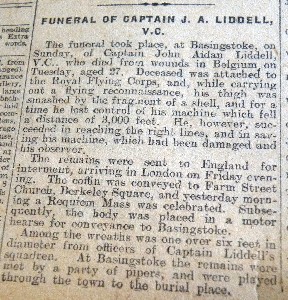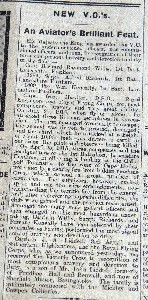De Ruvigny Roll of Honour Vol. 2 page 201
Newcastle Daily Chronicle Wed 25/08/1915

Newcastle Daily Chronicle Wednesday 09/06/1915

Newcastle Daily Chronicle Wed 25/08/1915
Royal Aero Club Certificate photograph
John Aidan Liddell was born on the 3rd August 1888 at Benwell Hall, Newcastle-upon-Tyne. He was the eldest son of six children of John Liddell, [29th March 1852 - October 1930], of Sherfield Manor, Basingstoke. J.P. for Northumberland, and his wife Emily Catherine, [born 8th November 1860, at Nusseerabad, Bengal, India, died March 1934], they were married in January 1887, 2nd daughter of the late Major Henry Asurmede Berry, (Cameronians), [born 1817 Liverpool, and who married Eliza McCarthy born 1822, Banagher, Leitrim, Ireland], and was married in 1840 in Bombay.
In 1898 the family moved to Prudhoe Hall. By 1904 they moved to southern England, residing at Sydmonton Court, near Newbury, until finally in June 1908, they resided at Sherfield Manor.
All the children had nicknames, Dorothy Mary, [Doll or Dolly Tabby or Tabitha], (1890 - 25th May 1938), Lancelot Charles, [Lance or Pows], (6th January 1891 - 10th April 1954 at Wetheral, Cumberland), he joined the Royal Navy and was a sub Lieutenant on HMS Monarch, Cuthbert Henry, [Bertie, Cuddie or Weary], was a Captain in the 15th Hussars, (1892 - 30th November 1959), Mary Monica, [Toad], (April 1894 - 1960) and Veronica Mildred, [Clara or Clam], (born Prudhoe, Northumberland, July, 1899 died 20th March 1962 in Southern Rhodesia).
Aidan's grandfather, John, was born in 1811 and was a Freeman of the city of Newcastle-upon-Tyne from 1831. He also was a Tanner residing at Newgate Street and then Leazes Terrace from 1850. He died in 1888 at Benwell Hall.
John [Oozy], Aidan Liddell [and his brothers] were educated at Ushaw College, the Roman Catholic school and seminary, then Mrs Ware's Academy at Frognall Hall, Hampstead Preparatory School, leaving in 1900, then arriving at Stonyhurst College on the 20th September, [his brother Cuthbert joined in 1905], then Balliol College from 1908, Oxford (where he greatly distinguished himself, taking the Honour course in Zoology).
Accompanied an Astronomical Expedition to Vinaroz, Spain as Chief Assistant to Father Cortie. In 1905, he was 17 at the time, he took some remarkable photographs of the total eclipse of the sun with a 20 feet telescopic camera, of which he was in charge. Elected a member of the Royal Astronomical Society in February 1907.
He was very friendly, had an easy going disposition, Whilst at Oxford he was still suffering from the effects of the delicate health that had handicapped him as a boy. As an undergraduate he published a paper Limulus, which revealed his skill as an investigator and beautiful draughtsmanship.
After leaving Oxford, John was offered a travelling scholarship to investigate the fauna of the island of Krakatoa, which suffered a major volcanic eruption in 1883, but he turned it down to join the special reserve of officers. He was also a member of the Incorporated Company of Tanners at Newcastle-upon-Tyne.
He enlisted in the 3rd (Reserve) Battalion of the Argyll and Sutherland Highlanders as a 2nd Lieutenant on the 1st June 1912. On the 14th May 1914 he obtained a Pilot's Certificate nu 781 in a Vickers Biplane at the Vickers School at Brooklands. John was promoted to Lieutenant in July 1914.
Went to France with his regiment as part of the first draft to the 2nd Battalion, Argyll and Sutherland [Princess Louise's Own], British Expeditionary Force on the 28th August 1914. Reached France on the 1st September 1914.
He was put in charge of the Machine Gun Section, at one time he spent 43 consecutive days in the trenches without rest or change. On October 21st 1914, his luck and skill prevented an awkward situation at Le Maisnil, on the Aubers Ridge, with the skill he handled the machine guns. For this John was awarded the Military Cross [London Gazette, 18th February, 1915]. Was also Mentioned in Despatches [London Gazette, 17/02/1915] by F.[Field] M. [Marshall] Sir John French [now Lord].
Then promoted to Captain on the 2nd February 1915, and was attached to the 2nd Battalion.
The long spell in the trenches broke down his health, although he hung on for a long time before giving in. He was invalided home in January 1915, with Battle Fatigue.
As soon as he recovered he joined the Royal Flying Corps, and in May he was with the 7th Squadron, Royal Flying Corps. By July 23rd he was back at the front and within a fortnight had won the Victoria Cross. [London Gazette, 24/08/1915].
On the 29th July he made his first reconnaissance flight, 3 hours 50 minutes, in RE5 2458, over Ostend and Ghent, returned with eleven shrapnel holes in his plane, and on his second flight in E5 2457, on July 31st, he won his Victoria Cross.
"Whilst flying with an observer, some twenty miles behind the line between Ostend and Bruges a shrapnel shell burst near the plane, shattering his right thigh, and seriously damaging the machine. During the momentary unconsciousness that followed he dived nearly 3000 feet. With a superhuman effort he managed to regain control, and in spite of his condition and the continuous fire to which he was exposed he succeeded after half an hour's flight in landing his observer safely in our lines".
He was carried to the Hospital at La panne, and for a month fought gallantly, against septic poisoning. He had his leg amputated but died from Septicaemia.
An extract from "The London Gazette," 23/08/1915, records the following:-"For most conspicuous bravery and devotion to duty on 31st July, 1915. When on a flying reconnaissance over Ostend-Bruges-Ghent he was severely wounded (his right thigh being broken), which caused momentary unconsciousness, but by a great effort he recovered partial control after his machine had dropped nearly 3,000 feet, and notwithstanding his collapsed state succeeded, although continually fired at, in completing his course, and brought the aeroplane into our lines - half an hour after he had been wounded. The difficulties experienced by this officer in saving his machine, and the life of his observer, cannot be readily expressed, but as the control wheel and the throttle control were smashed, and also one of the under-carriage struts, it would seem incredible that he could have accomplished his task."
He died at La Panne on the 31st August 1915 of the wounds received on the above occasion, his mother was by his side. His body was conveyed to London on the 3rd September and was interned in the Roman Catholic section.
His Colonel wrote: We were very proud of our V.C., and he will always be affectionately remembered, not only for the honour gained for us, but also for his great abilities and delightful disposition, There has certainly been no more splendid instance of devotion to duty throughout this war, and no brighter example of all a soldier could wish to be or to do.
One of his senior officers wrote: I cannot write much, for we all feel as if a light has gone out, the light of our battalion. You see, he was always bright. In snow, in muddy trenches, or ante-room, he kept us laughing, and his influence will last. Soldiering had little to teach him or give to him. His, by instinct, was the great gift a soldier can possess, and he gave it freely together with his life-to soldiering.
In forwarding the attached report by 2nd Lieutenant Peck on an encounter with a hostile aeroplane. I should like to call attention to the following points, as in my opinion, it was a remarkably good piece of work by both pilot and observer in bringing their machine safely back. Captain Liddell is a comparatively young pilot and was only on his second reconnaissance. He has had ones weeks experience of flying RE5 machines which undoubtedly require more judgement than most to land. In spite of his leg being broken very badly, with apparently 4 inches of bone shot away he flew his machine back over the lines at a height of 2.800 feet. An experienced pilot would have difficulty in flying and landing the machine under the circumstances in which he was placed, with one hand he worked the wheel control which was broken in half by bullets and with the other he worked the rudder. His throttle was shot away but he rightly drove the machine down with the engine on to ensure of hitting the aerodrome and then switched off.
Captain Liddell sat for half an hour in his machine to await the arrival of a doctor as he considered his leg would still be further damaged if inexperienced hands lifted him out of the machine. He then put a splint on his leg and himself applied a tourniquet to stop the bleeding.
Source : De Ruvigny Roll of Honour
Newcastle Journal Monday, 30/08/1915 reports:
Captain J. A. Liddell. V.C.
Undergoes an operation and has a leg amputated.Captain J.A. Liddell, V.C., of the Argyll and Sutherland Highlanders and the Royal Flying Corps, who was wounded on July 31st, has had to undergo an operation, and one of his legs had to be amputated in order to save his life. Captain Liddell, who formerly resided at Prudhoe Hall and Benwell, and who belongs to a local family intimately connected with the Mickley and Cowpen Collieries, was seriously wounded as a result of the exploit by which he recently earned the Victoria Cross. He was carrying out a reconnaissance at the time, and, though repeatedly shot and hit, he managed to bring down his machine safely into the British lines and save the life of the observer who was flying with him at the time."
Newcastle Journal Thursday, 07/10/1915 reports:
The Late Captain J. A. Liddell V.C.
A special memorial service has been held at Stonyhurst College, Lancashire, for the repose of the soul of the late Captain John Aidan Liddell, V.C., Argyll and Sutherland Highlanders, formerly of Newcastle. The College Officer's Training Corps took a leading part in the service. The catafalque in the chancel was covered with the Union Jack, and upon it were laid the late captain's busby and sword. The College Corps marched to the church with muffled drums playing, and after the service a hollow square was formed in the open, with the remains in the middle, and the "Last Post" was sounded. Amongst the mourners present were the late captain's parents, Mr and Mrs John Liddell his sisters, and Lieut. Cuthbert Liddell.
Newcastle Daily Chronicle 25/08/1915 carries a photo of Capt. Liddell and a report on the award of the Victoria Cross.
John was told about his award on the 18th August, but his actual Medal was presented to his father John Liddell JP by King George V at Buckingham Palace.
In his will dated 2nd March he left John Liddell esquire £928 2s 2d.
His Victoria Cross and other medals are on display in the Lord Ashcroft Gallery of the British Imperial War Museum in London, England. A memorial in his honour was erected in the Scottish Naval and Military Residence in Edinburgh, Scotland and also in the chapel at Balliol College.
There is an excellent book about John Aidan Liddell With a Smile and a Wave, the Life of Captain Aidan Liddell VC MC by Peter Daybell, Pen & Sword Books Ltd, ISBN 9781844151608, 2005.
John Aidan Liddell is remembered at Newcastle on NUT149 and NUT270.
His brothers are remembered on the same War Memorial.
There is also a font to his memory at Pickering.
More photographs from the Liddell Family
Brief Biography of John Aidan Liddell
The CWGC entry for Captain Liddell

